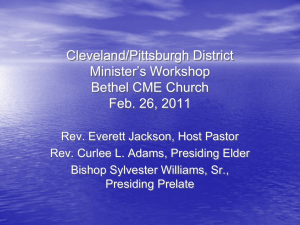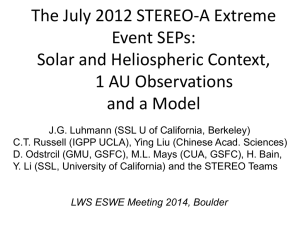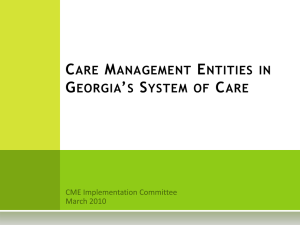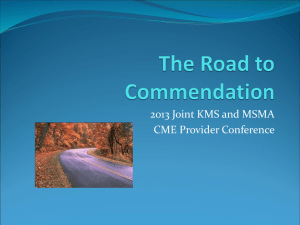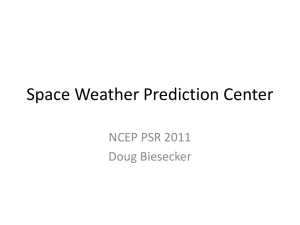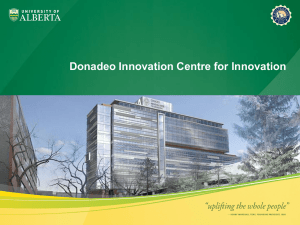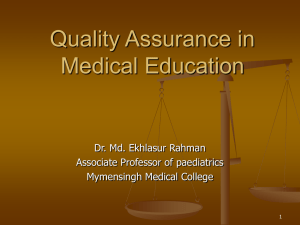ESWW10_Nov2013
advertisement
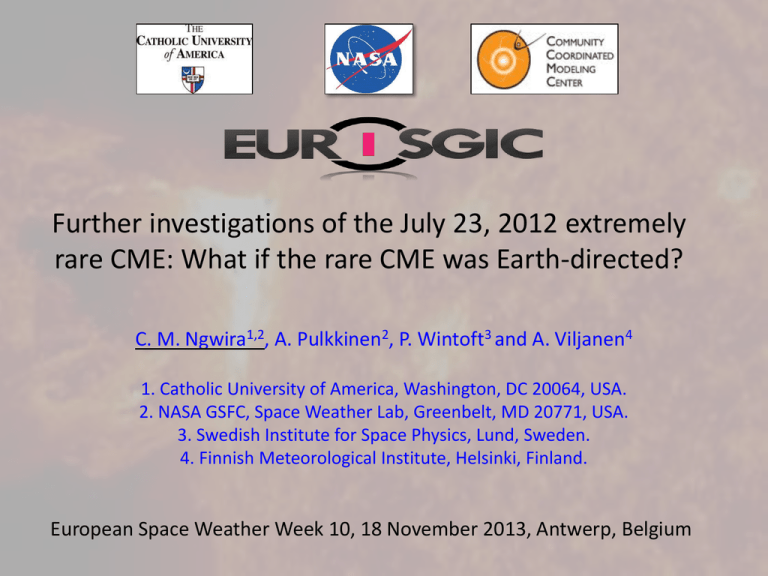
Further investigations of the July 23, 2012 extremely rare CME: What if the rare CME was Earth-directed? C. M. Ngwira1,2, A. Pulkkinen2, P. Wintoft3 and A. Viljanen4 1. Catholic University of America, Washington, DC 20064, USA. 2. NASA GSFC, Space Weather Lab, Greenbelt, MD 20771, USA. 3. Swedish Institute for Space Physics, Lund, Sweden. 4. Finnish Meteorological Institute, Helsinki, Finland. European Space Weather Week 10, 18 November 2013, Antwerp, Belgium Outline • Introduction i. Motivation for this work. ii. STEREO mission iii. Global MHD modeling • Simulation Results: i. July 23 event initial analysis (Ngwira et al., 2013b) ii. Further analysis of July 23 event • Summary and conclusions What is our interest? • Extreme space weather impact on ground infrastructure. • To determine the levels of induced electric fields on the ground during extreme space weather events. • Application for hazard management of electric power systems against geomagnetic induced currents. Motivation for this work • On July 23, 2012, a CME was hurled from the Sun’s active region AR1520 with a Rare speed of 2500 ± 500 km/s [Baker et al., 2013; Ngwira et al., 2013b]. • Event observed by NASA’s STEREO (Solar TErrestrial RElations Observatory) ahead spacecraft. • CME traveled a distance ~1 AU in about 19-hours. • Maximum observed in-situ speed of 2300 ± 100 km/s. • Question! What if this CME was Earth-directed? Animation courtesy of M. Leila Mays NASA’s STEREO mission • The STEREO mission comprises two twin spacecrafts launched in October 2006. • Mission objective is to understand CME initiation and propagation. • Together with SOHO, “special” CME observations can be made. • In-situ solar wind plasma and magnetic field data measured by the PLASTIC and IMPACT instruments respectively. http://stereo-ssc.nascom.nasa.gov/where.shtml July 23, 2012 event studies • Russell et al, [2013] provides an account of the STEREO-A magnetic field, plasma and energetic particle observations. • Baker et al., [2013] studied the event using geomagnetic storm forecast model and found that the Dst would have been about 500 nT had the CME been Earthward directed. • Ngwira et al., [2013b, accepted in SW] used a global MHD model to analyze the response of the ground induced electric fields. Modeling platform • Consider STEREO-A observations to represent the upstream L1 solar wind boundary conditions. • Space Weather Modeling framework (SWMF): University of Michigan physics-based model [Toth et al., 2005]. • The global magnetosphere is represented by the Block-Adaptive-Tree Solar wind Roe-type Upwind Scheme code (BATS-R-US) [Powell, 1999]. • We use the SWMF 2013 version through the CCMC run-on-request system. • All modeled results are at 1-minute sampling. Ground electric field modeling chain E y ,x m i e 4 B x ,y Viljanen and Pirjola, [1989] Simulation results: Summary of Ngwira et al., [2013b] initial analysis. STEREO-A observations/ENLIL density Ngwira et al., [2013b] Geomagnetic/geoelectric field response Ngwira et al., [2013b] Maximum global geoelectric fields Ngwira et al., [2013b] Simulation results: Further analysis of July 23 event. What if Bz was reversed? Dst index comparisons Sample electric field time series Electric field response using observed & reversed Bz Comparisons with previously observed events Ngwira et al., [2013a] Original Vs half WSA-ENLIL density Summary of results • Maximum simulated electric field around 1214 ± 2 V/km. • Comparable to March 1989 and Halloween 2003 storm effects. • Weak dependence between sign of Bz and Efield also seen by Wintoft et al., [2005]. • Noteworthy mid-latitude induced electric fields about 2-5 times compared to records of previously observed earth-directed events. Conclusions • The 23 July 2012 event produced one of the fastest CMEs on record. • CME was directed away from Earth but towards one of NASA’s STEREO spacecrafts. • We used STEREO-A observations as upstream L1 driving conditions for the MHD simulations. • Had the CME hit Earth, it would have produced some of the largest geomagnetically induced electric fields. • However, these are comparable to March 1989 and October 2003 storms. • Study has important practical application for risk management of power network grids. Acknowledgements • This research work is sponsored through the EU/FP7 EURISGIC Project funding.
